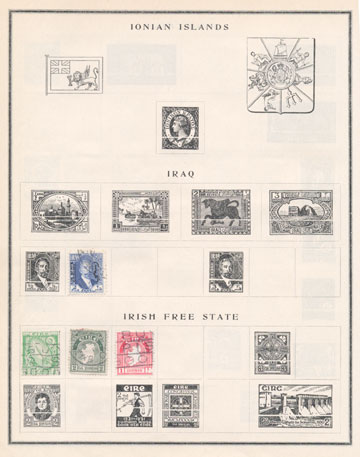There are many ways to keep and maintain a stamp collection. At first, envelopes or a cigar box might do the job. As a collection grows, you will find other tools to make your collection easier to organize and to examine. One thing to keep immediately in mind is that stamps are made of paper and are easily damaged. It’s best to avoid handling stamps directly with one’s fingers due to the risk of fingerprints, smudges, and other problems. Special tweezers, referred to by collectors as “tongs,” make handling stamps easy while protecting them from dirty fingers.
Commercially available printed albums are commonplace for worldwide collectors or for collectors of specific countries. Album pages and binders are available at a wide variety of price points and configurations, and either show images of the stamps or contain numbers or other descriptive text allowing collectors to match stamps to a proper place in an album. Completing an album page is a great pleasure and accomplishment for many collectors. Printed albums can, however, be expensive, and they lack flexibility – someone else has arranged the material so the collector is left to follow the arrangement, with limited ability to add additional stamps or to remove spaces for stamps that are unavailable, out of budget, or not of interest. Other collectors make their own album pages (either hand drawn or using computer software), which can be time consuming but allows for great flexibility.

Stamps can be mounted in albums using hinges or mounts. Hinges are small folded strips of gummed glassine paper that can be moistened to attach to a stamp and then to the album page. They are inexpensive but less protective of stamps and can lead to damage if improperly attached or removed. Mounts are generally plastic (such as polystyrene) that covers the front and back of a stamp and shield it from damage or from falling out of an album. The mount is then attached to the page. Mounts are far more expensive than hinges and add weight and thickness to stamp albums, but can make an attractive presentation. Some stamp albums are available as “hingeless” albums with mounts already placed and ready to receive stamps.

Larger items can be affixed using hinges, large mounts, or sometimes (such as with covers) with mounting corners (gummed or self adhesive) similar to those used for scrapbooking or photo albums.
Stamps can also be placed in stock pages or stock books, which have pages with glassine or acetate strips, or multiple pockets, where stamps can be arranged to suit the collector’s needs. Products vary widely in pocket size and the visibility of material placed within. Pre-bound books provide a convenient and affordable flexible option; stock pages are more expensive but can be freely arranged in a 3 ring or other binder.
Environmental Conditions
However you choose to mount your stamps, keep in mind that (most) stamps are made of paper and are relatively fragile. When you store your collection, do your best to avoid extremes of heat and cold, as well as humidity (which can be controlled in small areas with silica gel or another desiccant). Similarly, light exposure can be rough on stamps, especially red shades, and lead to fading. A dark space away from natural light is best.
Store albums upright and not too tightly compacted; stamps can develop gum damage or get stuck in humid environments or under pressure. Water is very dangerous to stamp collections. At the same time, some air circulation is useful to avoid brittleness. Stamps are also sensitive to mold, mildew, smoke and other contaminants and odors, and it’s always a good idea to keep food and beverages away from your stamps when working on your collection.
It’s also worth noting that most stamp albums and other paper products are not acid free or lignin free. Therefore, they may not be archivally safe for long term storage. Some plastics contain softeners or plasticizers which can also be dangerous to stamps in the long term. Mylar, polystyrene or other archival materials cost more, but are the safest option for valuable material.
For another take on storage and display, here’s a more detailed article put together by dealer Brixton-Chrome Inc.



